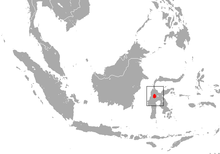
Primates is an order of mammals, which is further divided into the strepsirrhines, which include lemurs, galagos, and lorisids; and the haplorhines, which include tarsiers and simians. Primates arose 85–55 million years ago first from small terrestrial mammals, which adapted for life in tropical forests: many primate characteristics represent adaptations to the challenging environment among tree tops, including large brain sizes, binocular vision, color vision, vocalizations, shoulder girdles allowing a large degree of movement in the upper limbs, and opposable thumbs that enable better grasping and dexterity. Primates range in size from Madame Berthe's mouse lemur, which weighs 30 g (1 oz), to the eastern gorilla, weighing over 200 kg (440 lb). There are 376–524 species of living primates, depending on which classification is used. New primate species continue to be discovered: over 25 species were described in the 2000s, 36 in the 2010s, and six in the 2020s.

Tarsiers are haplorhine primates of the family Tarsiidae, which is, itself, the lone extant family within the infraorder Tarsiiformes. Although the group was, prehistorically, more globally widespread, all of the species living today are restricted to Maritime Southeast Asia, predominantly being found in Brunei, Indonesia, Malaysia and the Philippines.

Tarsiiformes are a group of primates that once ranged across Europe, northern Africa, Asia, and North America, but whose extant species are all found in the islands of Southeast Asia. Tarsiers are the only living members of the infraorder; other members of Tarsiidae include the extinct Tarsius eocaenus from the Eocene, and Tarsius thailandicus from the Miocene. Two extinct genera, Xanthorhysis and Afrotarsius, are considered to be close relatives of the living tarsiers, and are generally classified within Tarsiiformes, with the former grouped within family Tarsiidae, and the latter listed as incertae sedis (undefined). Omomyids are generally considered to be extinct relatives, or even ancestors, of the living tarsiers, and are often classified within Tarsiiformes.

The Philippine tarsier, known locally as mawumag in Cebuano and other Visayan languages, and magô in Waray, is a species of tarsier endemic to the Philippines. It is found in the southeastern part of the archipelago, particularly on the islands of Bohol, Samar and Leyte. It is a member of the approximately 45-million-year-old family Tarsiidae, whose name is derived from its elongated "tarsus" or ankle bone. Formerly a member of the genus Tarsius, it is now listed as the only member of the genus Carlito, a new genus named after the conservationist Carlito Pizarras.

The Sangihe tarsier, also known as Sangihe Island tarsier, is a small primate found on Sangir Island, which is located about 200 kilometers north-east of the island of Sulawesi in Indonesia. In 2008 a population of the Sangihe tarsier was determined to be a distinct species, the Siau Island tarsier. Locally in the Sangihe dialect of Sangir language, tarsiers are called Senggasi or Higo.

Horsfeld's tarsier is the only species of tarsier in the genus Cephalopachus. Named by American naturalist Thomas Horsfield, it is also referred to as western tarsier. The species occurs on Borneo, Sumatra and nearby islands and is, like other members of the group, entirely nocturnal.
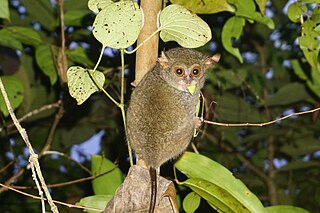
The Peleng tarsier, or the Peleng Island tarsier, is a nocturnal primate found on the island of Peleng, just east of Sulawesi, Indonesia. In western Peleng, the animal is called Lakasinding, while in the east, Siling.
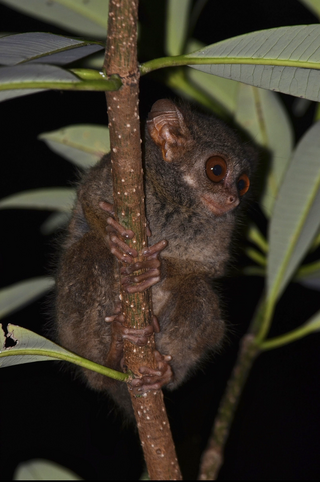
Dian's tarsier, also known as the Diana tarsier, is a nocturnal primate endemic to central Sulawesi, Indonesia. Its head-body length is 11.5–12 centimetres (4.5–4.7 in) and it has a tail of 22 centimetres (8.7 in). Dian's tarsier lives in rainforests. It was formerly called T. dianae, but that has been shown to be a junior synonym.

The pygmy tarsier, also known as the mountain tarsier or the lesser spectral tarsier, is a nocturnal primate found in central Sulawesi, Indonesia, in an area with lower vegetative species diversity than the lowland tropical forests. The pygmy tarsier was believed to have become extinct in the early 20th century. Then, in 2000, Indonesian scientists accidentally killed one while trapping rats. The first pygmy tarsiers seen alive since the 1920s were found by a research team led by Dr. Sharon Gursky and Ph.D. student Nanda Grow from Texas A&M University on Mount Rore Katimbo in Lore Lindu National Park in August 2008. The two males and single female were captured using nets, and were radio collared to track their movements. As the first live pygmy tarsiers seen in 80-plus years, these captures dispelled the belief among some primatologists that the species was extinct.
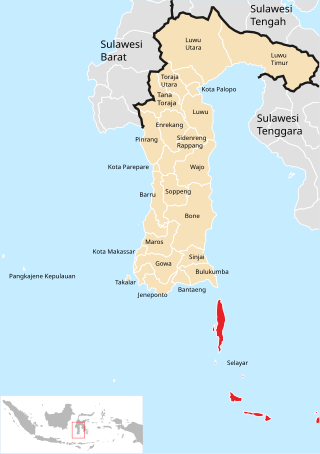
Spectral tarsier or Selayar tarsier is a species of tarsier found on the island of Selayar in Indonesia. It is apparently less specialized than the Philippine tarsier or Horsfield's tarsier; for example, it lacks adhesive toes. It is the type species for the genus Tarsius. While its range used to also include the population on nearby southwestern Sulawesi, this population has been reclassified as a separate species, Tarsius fuscus. Some of the earlier research published on Tarsius spectrum refers to the taxon that was recently reclassified and elevated to a separate species, the Gursky's spectral tarsier.

The Mentawai langur is a species of primate in the family Cercopithecidae. It is endemic to the Mentawai Islands in Indonesia. Its natural habitat is subtropical or tropical dry forests. The Siberut langur was formerly considered a subspecies of the Mentawai langur.

The Siau Island tarsier is a species of tarsier from the tiny volcanic island of Siau in Indonesia. The T. tumpara species is one of 14 species and 7 subspecies in the tarsier family called "Tarsiidae". They belong to the Haplorrhini suborder, known as the "dry-nosed" primates. The tarsier's eyes are so big that they do not move in its socket and they are almost as big as its brain. Locally in the Siau dialect of Sangir language, the tarsiers are called Tumpara. The name differs from the Sangihe dialect which called tarsiers, Senggasi or Higo, these names are used for the Sangihe tarsier instead.
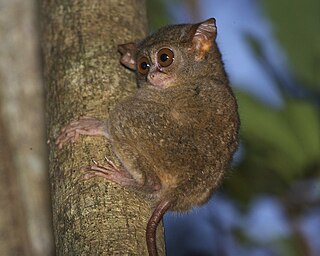
Tarsius is a genus of tarsiers, small primates native to islands of Southeast Asia. Until 2010, all tarsier species were typically assigned to this genus, but a revision of the family Tarsiidae restored the generic status of Cephalopachus and created a new genus Carlito.
Wallace's tarsier, Tarsius wallacei, is a species of Sulawesi tarsier. It is found in the forests of what is referred to geologically as the neck of Sulawesi where there are two separate populations. It is a small brown arboreal primate of the infraorder Tarsiiformes less than 15 cm (6 in) long.
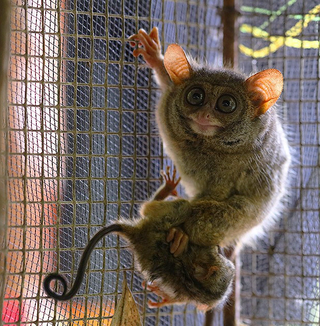
The Makassar tarsier, also known locally as Balao Cengke, is a species of tarsier. Its range is in Indonesia in the southwestern peninsula of the island of Sulawesi, South Sulawesi, near Makassar. At one point the taxon was downgraded to a junior synonym of the spectral tarsier. However, when that species' range was restricted to the population on a single island near Sulawesi, this nomen was resurrected to contain the remainder of that species.

Gursky's spectral tarsier, also known locally as Wusing, is a species of tarsier found in the island of Sulawesi in Indonesia. A recent taxonomic revision split this species off from the spectral tarsier and other tarsier species based on difference in vocalisations and pelage. These tarsiers, like other species of primates, are able to communicate with other individuals of the same species through flexible call patterns, in which they output different note patterns based on their duet partner's calls.
The Jatna’s tarsier, also known locally as Mimito, is a species of tarsier endemic to the northern Sulawesi, Gorontalo, Indonesia. Previously classified together with the Spectral tarsier, this species was reclassified and elevated as a separate species in 2017 due to their distinct and separate acoustic duet calls between males and females.

The Sulawesi lowland rain forests is a tropical moist forest ecoregion in Indonesia. The ecoregion includes the lowlands of Sulawesi and neighboring islands.
